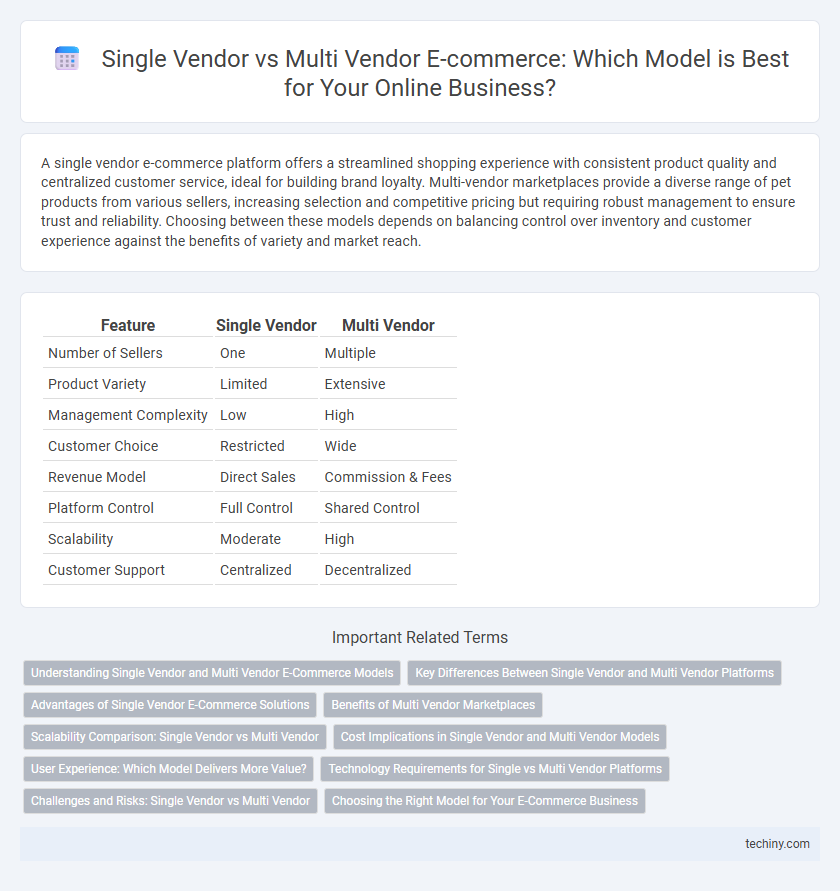A single vendor e-commerce platform offers a streamlined shopping experience with consistent product quality and centralized customer service, ideal for building brand loyalty. Multi-vendor marketplaces provide a diverse range of pet products from various sellers, increasing selection and competitive pricing but requiring robust management to ensure trust and reliability. Choosing between these models depends on balancing control over inventory and customer experience against the benefits of variety and market reach.
Table of Comparison
| Feature | Single Vendor | Multi Vendor |
|---|---|---|
| Number of Sellers | One | Multiple |
| Product Variety | Limited | Extensive |
| Management Complexity | Low | High |
| Customer Choice | Restricted | Wide |
| Revenue Model | Direct Sales | Commission & Fees |
| Platform Control | Full Control | Shared Control |
| Scalability | Moderate | High |
| Customer Support | Centralized | Decentralized |
Understanding Single Vendor and Multi Vendor E-Commerce Models
Single vendor e-commerce platforms involve a single seller managing product listings, inventory, and transactions, providing streamlined control and consistent branding. Multi vendor e-commerce models host multiple sellers on one platform, offering diverse product selections and competitive pricing but requiring complex management of vendor relationships and order coordination. Understanding these distinctions helps businesses choose the optimal approach for scalability, customer reach, and operational efficiency.
Key Differences Between Single Vendor and Multi Vendor Platforms
Single vendor platforms are managed by one seller who controls product selection, pricing, and inventory, providing a streamlined shopping experience with consistent quality and service. Multi vendor platforms host multiple independent sellers, offering a wider range of products, competitive pricing, and diverse brand options, but requiring robust management to ensure quality and delivery standards. Key differences include control over product listings, revenue models, customer support, and scalability potential, impacting operational complexity and market reach.
Advantages of Single Vendor E-Commerce Solutions
Single vendor e-commerce solutions streamline inventory management and simplify order processing by centralizing control under one seller, reducing operational complexity. These platforms often provide more consistent product quality and better customer service, as the vendor is solely responsible for all transactions and customer interactions. Businesses benefit from enhanced brand coherence and easier performance tracking, optimizing marketing strategies and sales analytics.
Benefits of Multi Vendor Marketplaces
Multi vendor marketplaces offer enhanced product diversity and extensive inventory, attracting a broader customer base and increasing sales potential. These platforms reduce operational risks by distributing responsibilities among multiple vendors, improving scalability and resilience. Access to competitive pricing and varied seller expertise fosters improved customer satisfaction and loyalty.
Scalability Comparison: Single Vendor vs Multi Vendor
Multi-vendor e-commerce platforms offer superior scalability by accommodating numerous sellers, increasing product variety and customer reach without significant infrastructure changes. Single vendor platforms face scalability limitations due to inventory constraints and reliance on a solitary supply chain, restricting growth potential. Expanding a multi-vendor marketplace supports rapid market penetration and diversified revenue streams compared to single vendor models.
Cost Implications in Single Vendor and Multi Vendor Models
Single vendor e-commerce models often incur higher upfront costs due to exclusive inventory management, warehousing, and supplier negotiations, resulting in increased operational expenses. Multi vendor platforms distribute costs by enabling numerous sellers to manage their inventory and logistics independently, leading to reduced infrastructure investment and lower fixed costs for the platform owner. Transaction fees and commission structures vary, with multi vendor models typically generating revenue through commissions on sales, while single vendor systems rely more on product margin optimization and bulk purchasing advantages.
User Experience: Which Model Delivers More Value?
Single vendor e-commerce platforms offer a streamlined user experience with consistent product quality and unified customer service, reducing decision fatigue and enhancing trust. Multi-vendor marketplaces provide greater product variety and competitive pricing, but can introduce inconsistencies in delivery times and customer support, potentially complicating the shopping journey. Evaluating user experience value depends on whether customers prioritize simplicity and reliability or extensive choice and price competitiveness.
Technology Requirements for Single vs Multi Vendor Platforms
Single vendor e-commerce platforms require streamlined inventory management systems, centralized payment gateways, and tailored CRM solutions to ensure seamless operations and personalized customer experiences. Multi vendor platforms demand robust scalability, advanced vendor onboarding modules, complex commission and payout mechanisms, and comprehensive multi-channel integration to efficiently handle diverse sellers and product catalogs. Both platform types benefit from secure APIs, real-time analytics, and responsive UX/UI designs, but multi vendor setups emphasize enhanced moderation tools and dispute resolution systems to maintain marketplace integrity.
Challenges and Risks: Single Vendor vs Multi Vendor
Single vendor e-commerce platforms face challenges such as limited product variety and dependency risk on a single supplier, which can lead to stockouts and reduced customer retention. Multi-vendor marketplaces encounter complexities in managing multiple sellers, including quality control issues, inconsistent customer service, and disputes over commission structures. Both models carry risks related to platform security, fraud prevention, and scaling operational efficiency, requiring tailored strategies to mitigate these challenges.
Choosing the Right Model for Your E-Commerce Business
Selecting between a single vendor and multi-vendor model depends on your e-commerce business goals, product range, and management capacity. Single vendor platforms offer streamlined operations and consistent branding, ideal for niche markets or exclusive product lines. Multi-vendor marketplaces provide diverse product offerings and scalability but require robust seller management and quality control systems.
Single Vendor vs Multi Vendor Infographic

 techiny.com
techiny.com